Fish
Find Your Grouper Match: Exploring Similar Fish
Uncover the mysterious world of groupers and discover their unique characteristics that make them fascinating creatures worth exploring further.
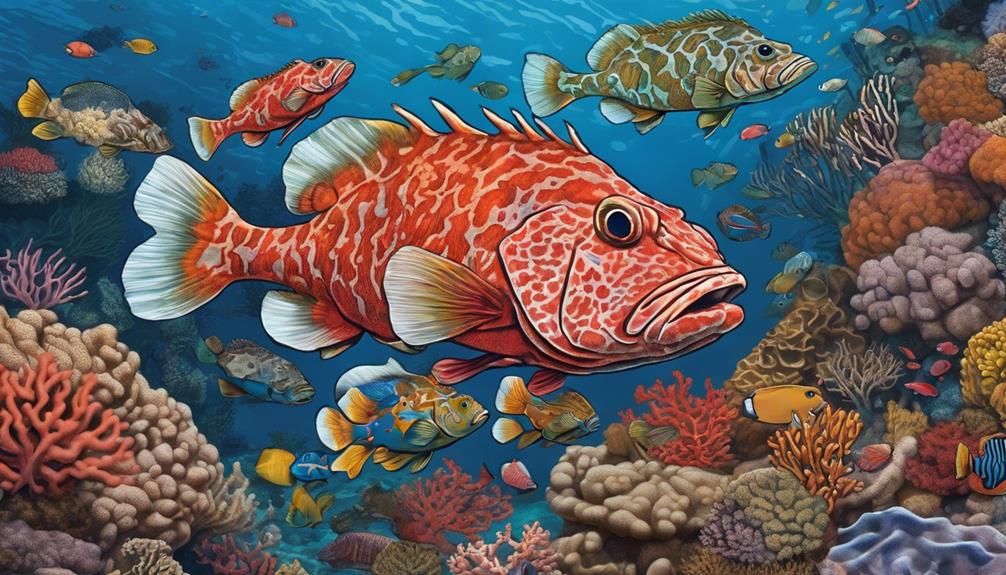
I love groupers, they hide in crevices and are essential creatures. They come together for spawning, have various feeding habits, and often hunt alone. They use their strong jaws to catch prey and strike when food appears. Groupers prefer habitats near structures, such as reefs and ledges, in both shallow and deep waters. Recognize them by size variations and habitat preferences. Some common types include Gag, Red, and Black Grouper. Fishing for them requires patience with heavy tackle. Groupers are crucial for marine ecosystems and need protection. Learn more about these fascinating fish!
Key Takeaways
- Consider size, habitat, and behavior for matching
- Look for similar feeding habits and territorial behavior
- Explore diverse grouper species for comparisons
- Identify based on location preferences and physical traits
- Recognize importance in marine ecosystems and conservation efforts
Understanding Grouper Behavior
When targeting grouper while fishing, understanding their behavior becomes essential. Groupers are really good at hiding in crevices or structures, waiting to ambush their prey. This behavior makes it important to place your bait strategically to entice them out.
Additionally, groupers exhibit territorial behavior, often sticking to specific areas for extended periods. By knowing where they prefer to stay, you can increase your chances of a successful catch.
While groupers are usually solitary, they may come together for spawning aggregations during certain times of the year. Being aware of these patterns can help you plan your fishing trips accordingly.
Groupers have varied feeding habits, with some being opportunistic feeders while others have a more specific prey preference. Understanding what type of feeder your target grouper is can guide your choice of bait and fishing technique.
Exploring Grouper Habitat
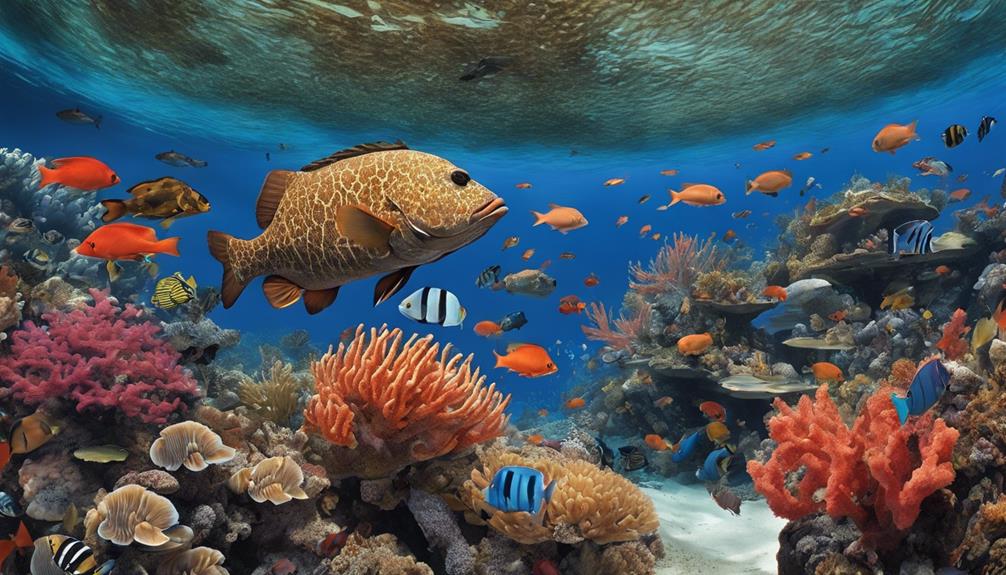
To effectively locate grouper for fishing, exploring their preferred habitats near structures like reefs, wrecks, and ledges is essential. Grouper are typically found in both shallow and deep waters where there are plenty of hiding spots like caves and crevices. These areas provide grouper with opportunities to ambush their prey, making them prime locations for anglers.
Whether in offshore or inshore waters, grouper are adaptable and can be targeted by anglers with varying preferences. By understanding the habitat preferences of different grouper species, anglers can greatly improve their chances of locating these elusive fish.
Rocky bottoms and underwater structures are key areas to explore when searching for grouper, as these environments attract and provide ideal conditions for them to thrive. By focusing on these habitats, anglers can increase their chances of encountering grouper and having a successful fishing experience.
Comparing Grouper Traits
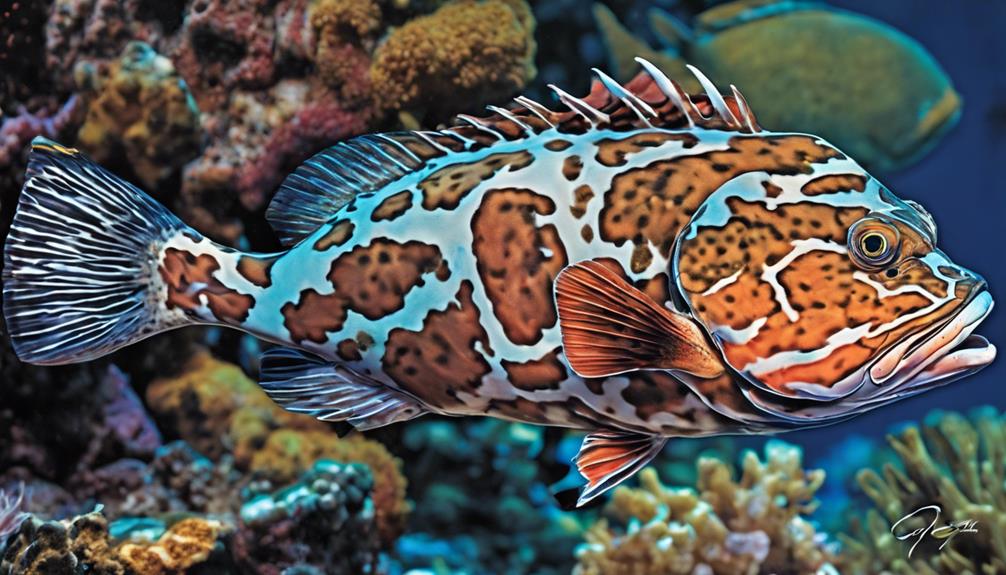
When comparing grouper traits, it's crucial to consider their size and habitat preferences. Groupers come in a variety of sizes, with some species growing over 8 feet long.
Their feeding behavior is also significant, as they use their powerful jaws and teeth to ambush and consume prey whole.
Size and Habitat
Exploring the size and habitat preferences of various grouper species reveals a fascinating diversity in their characteristics and behaviors. Groupers come in a range of sizes, with some growing up to 7 feet long and weighing over 800 pounds. These impressive fish can be found in various environments, from shallow coastal waters to deep offshore reefs and rocky bottoms.
Groupers have a strong affinity for structured habitats like coral reefs, wrecks, and underwater caves, using them as strategic locations to ambush their prey. Each grouper species has its unique habitat preferences; some thrive in sandy areas, while others prefer rocky ledges. Understanding the size and habitat preferences of different grouper species is essential for effectively targeting them during fishing expeditions.
Feeding Behavior
Groupers exhibit diverse feeding behaviors, showcasing their adaptability and predatory prowess in various marine ecosystems. These opportunistic feeders have a varied diet, consuming fish, crustaceans, and cephalopods. With their ambush predation technique, groupers patiently wait for unsuspecting prey before swiftly striking with their large mouths and powerful jaws.
Some species display territorial behavior, fiercely defending their feeding grounds from other predators. Anglers can benefit from understanding these feeding habits, as it helps in selecting the right bait and fishing methods for a successful catch. By observing and learning about grouper feeding behavior, one can appreciate the complexity and efficiency of these fascinating marine predators.
Identifying Grouper Species
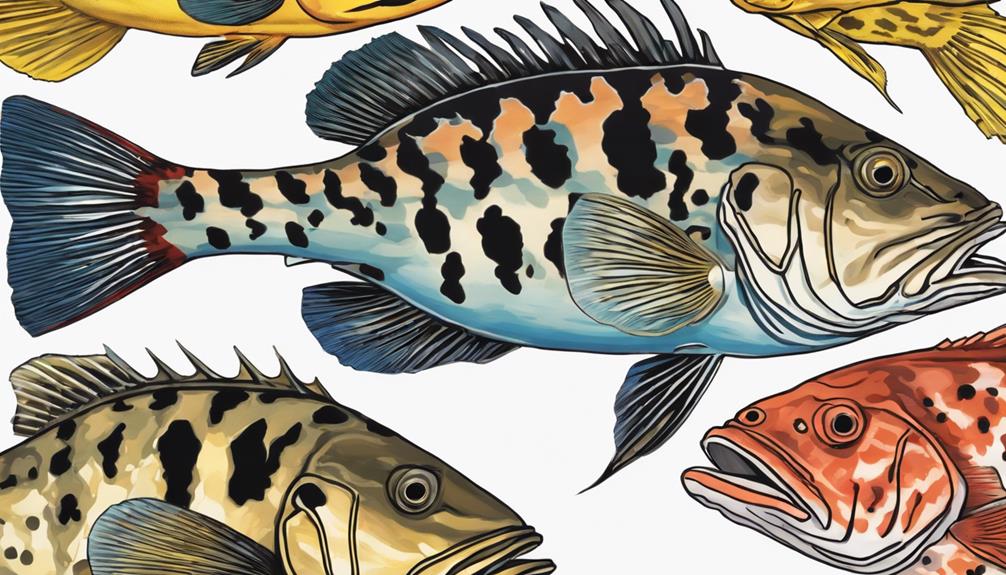
When identifying grouper species, it's essential to take into account their size variations, as groupers can range from a few pounds to over 800 pounds.
Understanding the habitat preferences of different grouper species is also vital for successful identification, as these fish inhabit various environments like reefs, wrecks, and mangroves.
Grouper Size Variations
Identifying different grouper species can be challenging due to their significant size variations. Grouper sizes range widely, with some species growing over 8 feet long and weighing hundreds of pounds. Common types like Gag, Red, Black, and Goliath Grouper have distinct size ranges.
Gag Grouper typically measure between 20 to 60 inches, while Red Grouper can reach up to 42 inches in length. Black Grouper are known to grow as long as 52 inches, and the massive Goliath Grouper can exceed 8 feet and weigh up to 800 pounds.
Recognizing these size differences is essential for proper identification and adherence to fishing regulations. Understanding the various sizes of grouper species enhances our ability to appreciate and protect these magnificent fish.
Grouper Habitat Preferences
Having discussed the size variations of different grouper species, it becomes imperative to understand their distinct habitat preferences in order to effectively locate and target these elusive fish. Grouper species exhibit diverse habitat choices, with each species favoring specific environments.
Red Grouper are commonly found in shallow waters up to 300 feet, while Gag Grouper prefer deeper waters up to 500 feet. Black Grouper tend to inhabit rocky ledges and wrecks, contrasting with Goliath Grouper, which favor mangrove roots and structures. Warsaw Grouper typically dwell in deep waters exceeding 600 feet, and Scamp Grouper are often associated with live bottom habitats.
Fishing Techniques for Grouper
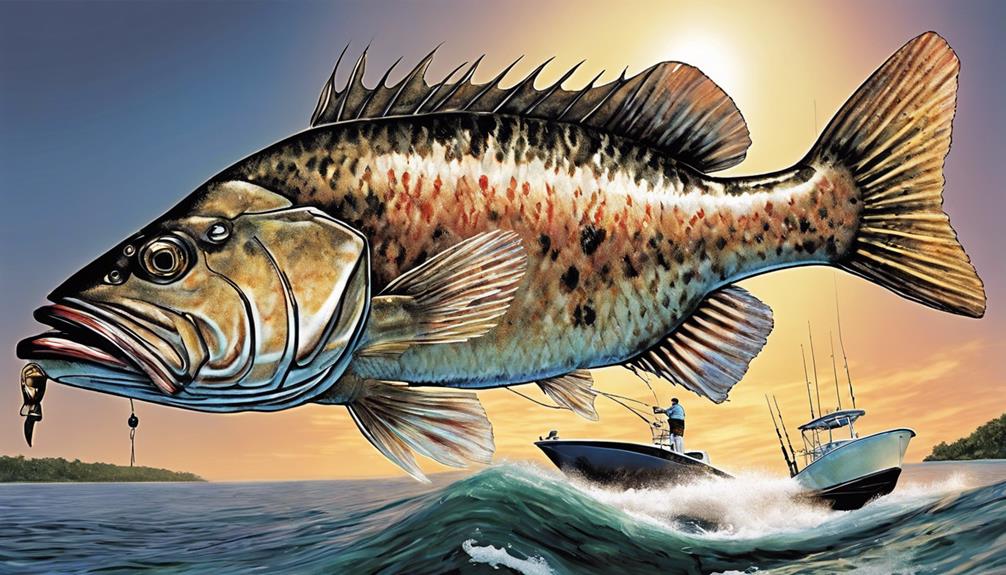
To reel in Grouper successfully, one must utilize heavy tackle and strong lines to match their powerful fighting abilities. When targeting Grouper, it's crucial to focus on structures like reefs, wrecks, and rock piles where they seek shelter and ambush prey.
Employing techniques such as vertical jigging, using live bait, or trolling can be effective in enticing Grouper to bite. Patience is key when fishing for Grouper, as they may take their time to locate and strike. Once hooked, be prepared for a challenging battle, as Grouper are renowned for their strength and determination.
- Heavy Tackle and Strong Lines: Match the power of Grouper for a successful catch.
- Target Structures: Focus on reefs, wrecks, and rock piles where Grouper hide.
- Technique Variety: Experiment with vertical jigging, live bait, and trolling methods.
- Patience Pays Off: Stay patient as Grouper may require time to commit to the bait.
Conservation Efforts for Grouper

In our ongoing efforts to protect Grouper populations, we implement various conservation strategies to guarantee their sustainability. Grouper species face threats from overfishing due to their slow growth and late maturity, making it essential to enact measures such as size and bag limits, closed seasons, and marine protected areas. These regulations help control grouper fishing activities, ensuring their numbers can replenish.
Collaborative initiatives involving fishermen, scientists, and policymakers work together to safeguard sustainable grouper populations. By incorporating bycatch reduction devices and gear modifications, accidental catches of grouper during fishing are minimized, aiding in their conservation.
Monitoring programs play a crucial role in tracking grouper populations, evaluating the effectiveness of conservation efforts, and shaping future management decisions. By actively participating in these conservation endeavors, we can contribute to the preservation of these remarkable fish for generations to come.
Frequently Asked Questions
What Fish Is Most Similar to Grouper?
Snapper closely resembles grouper in appearance, habitat, and diet. They both thrive in offshore and reef environments, feeding on crustaceans and fish. Anglers targeting grouper can also catch snapper using similar techniques and bait in shared spots.
What Fish Are Grouper Related To?
I'll share the connections between grouper and other fish. Grouper are related to species like sea bass and rockfish, showing similarities to snapper and amberjack. Understanding these relationships can enhance our fishing strategies.
What Does Grouper Compare To?
Grouper compares to various fish like snapper in habitat preference and bass in hunting tactics. Similar to cod, they dwell near the bottom. Some species reach remarkable sizes like halibut. When hooked, grouper show strength akin to amberjack or tuna.
Is Mahi Mahi the Same as Grouper?
No, Mahi Mahi and Grouper are not the same. Mahi Mahi is a vibrant, fast swimmer with a sweet, firm taste. Grouper, on the other hand, boasts a camouflaged appearance and a buttery, flaky texture. Each fish offers a unique culinary experience.
Conclusion
So, remember to choose your grouper match wisely. Just like finding the perfect friend, you want to make sure you have similar traits and habits.
Explore their habitat, compare their characteristics, and identify their species before casting your line. By understanding their behavior and using the right fishing techniques, you can increase your chances of catching the perfect grouper.
And don't forget to support conservation efforts to protect these amazing fish for future generations!
Dana is our Lead Content Writer, bringing a wealth of knowledge and expertise to our team. With a background deeply rooted in animal studies and a profound love for all creatures, Dana is dedicated to crafting engaging and informative content that resonates with our audience. With Dana at the helm, you can trust that our content is accurate and engaging, catering to the diverse interests of animal enthusiasts everywhere.
Fish
My Fish Staying in One Spot: A Guide to Active Behavior
Seeking to understand why your fish stays in one spot? Discover crucial insights on fish behavior and well-being in this comprehensive guide.
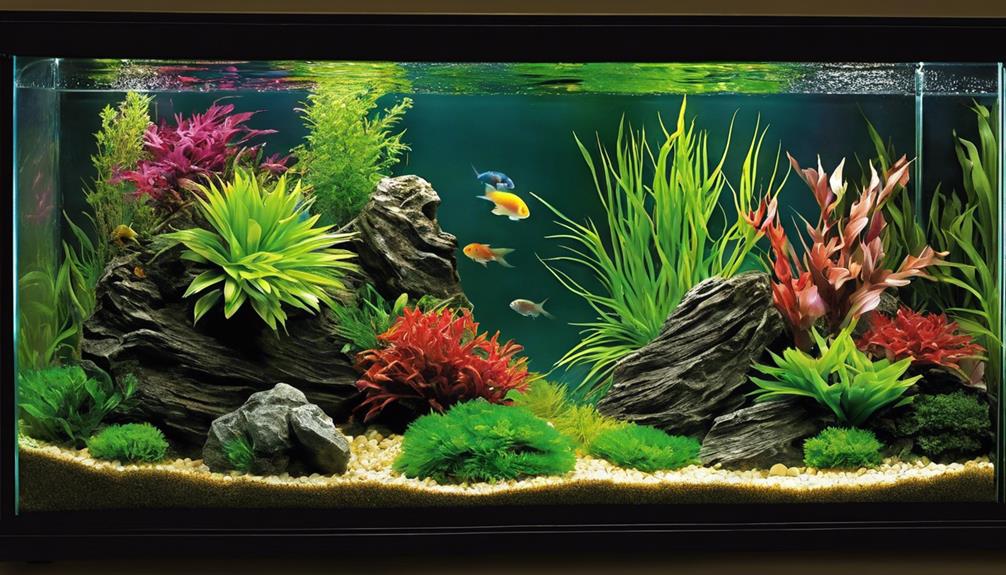
If your fish is staying in one spot, it might be a sign of distress. Watch for appetite changes, swim patterns, and tank interactions. Check water quality and decor influence; gill health is key for respiration. Track swimming activities and color changes for hints. Reduce stress with a diverse tank setup and a balanced diet. Regular monitoring, routine maintenance, and vital tactics are essential for a healthy aquarium. Understanding these aspects will help promote active behavior in your fish. More insights on creating an engaging environment and ensuring fish well-being await.
Key Takeaways
- Check water quality for issues affecting fish behavior.
- Ensure proper tank layout and stimulation for active swimming.
- Monitor fish for signs of distress or illness.
- Provide hiding spots and varied environments to reduce stress.
- Maintain a balanced diet to support fish health and activity.
Common Signs of Fish Distress
When observing fish behavior, it's important to be aware of common signs of distress that may indicate underlying health issues. One key indicator is when your fish stays at the bottom of the tank for extended periods. If your fish is usually active and swimming around but suddenly prefers the bottom, it could be a sign of distress. This behavior might suggest discomfort or illness, prompting a closer look at the water quality and the fish's overall well-being.
Ensuring your fish have good water conditions is vital for their health. Poor water quality can stress fish, leading to behaviors like staying at the tank's bottom. Monitor your fish for signs of distress and promptly address any water issues to help them thrive.
Additionally, observing your fish swimming around actively is a positive sign of well-being. If your fish is lively and exploring their environment, it usually indicates good health and contentment.
Watching for Appetite Changes
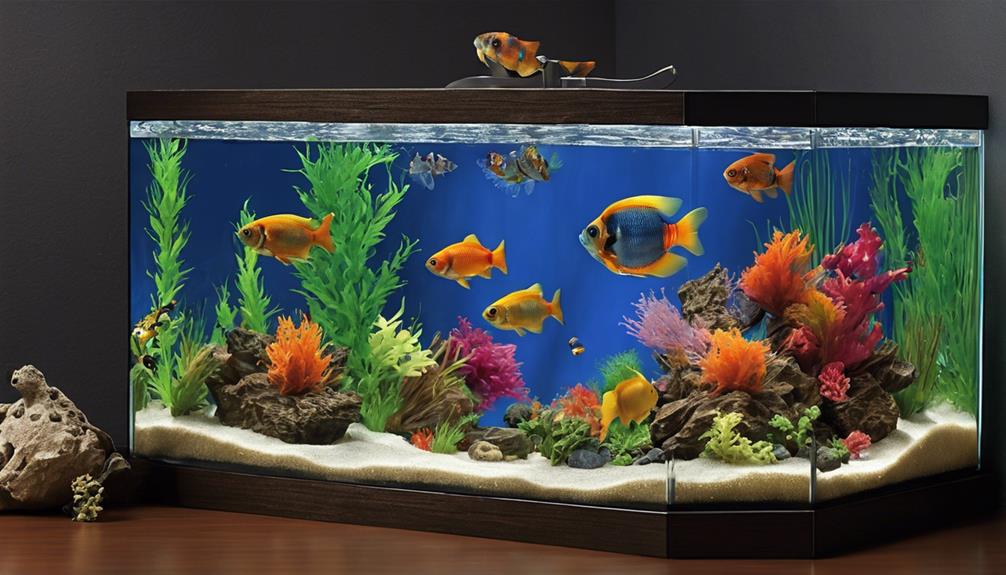
Monitoring fish appetite is important for detecting early signs of health issues and guaranteeing their well-being. Changes in appetite, such as an increase or decrease in feeding habits, can indicate underlying problems affecting fish behavior.
By regularly observing their eating patterns, you can detect signs of illness, stress, or poor water quality. Consistent feeding routines are essential for evaluating the health of your fish.
A loss of appetite in fish can lead to energy deficiency and weaken their immune systems, making them more susceptible to diseases. Hence, it's critical to pay attention to any appetite changes in your fish to address potential issues promptly.
Being Aware of Fish Behavior

When observing fish behavior, it's essential to pay attention to their movements and habits. Understanding how fish normally behave can help us recognize when something is amiss.
Being aware of changes in swimming patterns or unusual stillness can provide valuable insights into their well-being.
Observation Tips for Fish
Engaging with fish behavior involves keen observation of their swimming patterns, interactions with tank mates, and responses to environmental changes.
To effectively observe your fish, pay attention to their movements at different levels of the tank. Note if they're swimming near the bottom, which could indicate potential health issues or stress.
Watch for any unusual behaviors such as excessive hiding or sudden aggression towards other fish. By documenting these observations, you can track any changes over time.
Remember to also observe their feeding habits, coloration, and activity levels as these can be signs of underlying problems. Regular monitoring will help you establish a baseline for normal behavior and quickly identify any deviations that may require attention.
Understanding Fish Movements
To understand fish movements effectively, it's essential to consider how various factors such as tank layout, decor, and lighting influence their behavior. Fish behavior is intricately connected to efficient water flow within the tank. Proper water circulation is crucial for maintaining ideal oxygen levels, regulating temperature, and encouraging natural fish movement.
The positioning of essential equipment like heaters and filters also plays a significant role in shaping fish behavior. Water flow from filters, powerheads, and air pumps not only affects fish comfort but also influences their overall well-being. Balancing the water flow to prevent stagnant areas is key to ensuring a stimulating environment that promotes active fish behavior.
Understanding these dynamics can lead to a more enriching and fulfilling experience for both you and your aquatic companions.
Understanding Respiration Patterns
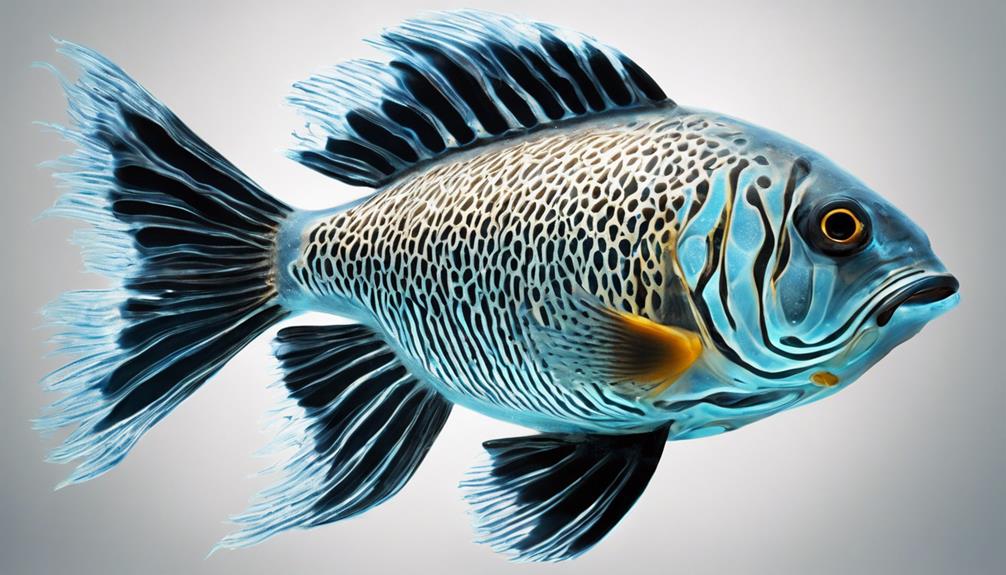
Fish respiration is an important aspect of their survival. It involves the exchange of oxygen and carbon dioxide through their gills. Understanding the variations in breathing frequency and the significance of maintaining healthy gills is essential for keeping fish in peak condition.
Breathing Frequency Variations
Understanding variations in breathing frequency is essential for monitoring the health of fish and detecting potential issues early. Fish species, water parameters, stress, and illness can all influence respiration patterns. To emphasize this point, consider the following table:
| Factors Affecting Respiration | Examples |
|---|---|
| Fish Species | Betta fish vs. Goldfish |
| Water Parameters | Temperature, oxygen levels |
| Stress or Illness | Sudden changes, infections |
Importance of Gill Health
Gill health plays an essential role in ensuring fish can effectively extract oxygen from water for respiration. The gills act as the primary site for oxygen exchange, allowing fish to breathe underwater. Healthy gills are critical for maintaining proper oxygen levels in the fish tank, supporting metabolic functions and overall well-being.
Monitoring gill movement is a key indicator of oxygen intake and respiratory efficiency. Damage to the gills can hinder respiration, leading to stress and health issues in fish. Maintaining good water quality is indispensable for excellent gill health. By ensuring a clean and well-aerated environment, you can help your fish thrive and exhibit active behavior in their habitat.
Monitoring Swimming Activity

When monitoring swimming activity in fish, it's crucial to track both the frequency and duration of their movements throughout the day. By observing how often and for how long your fish swims, you can gain valuable insights into their overall health and well-being. Changes in swimming patterns, such as increased activity or sudden bouts of lethargy, could indicate underlying issues like swim bladder problems or stress.
To effectively monitor swimming activity, note the areas in the tank where your fish prefers to swim. This can give you a better understanding of their habitat preferences and behavior. Additionally, observe how your fish interacts with tank mates while swimming to make sure they aren't being harassed or bullied, leading to stress.
Incorporating partial water changes into your routine can also help maintain ideal water quality, reducing stress levels for your fish and promoting healthy swimming behavior. By staying attentive to your fish's swimming activity and behavior, you can make sure they're happy and thriving in their aquatic environment.
Noting Changes in Fish Color
Noticing alterations in fish coloration is an essential aspect of monitoring their health and well-being. Fish color changes can provide valuable insights into their overall condition, serving as indicators of potential stress, illness, or environmental factors impacting their health.
Bright and vibrant colors typically signify important health, while pale or faded colors may suggest underlying issues that require attention. It's vital to pay attention to sudden color changes, as they can be warning signs of possible health problems that need immediate intervention.
Regularly monitoring your fish's color can help in detecting any abnormalities early on, allowing for timely action to be taken. By staying observant and noting any changes in their coloration, you can better understand your fish's well-being and make sure they remain happy and healthy in their environment.
Strategies to Reduce Stress

To effectively reduce stress in fish, providing hiding spots and stimulation is essential. Creating a diverse environment within the aquarium can help mimic their natural habitat and alleviate stress. Hiding spots, such as plants or caves, offer fish a sense of security, allowing them to retreat when feeling overwhelmed. Introducing stimulation through the addition of tank mates or rotating decor can also prevent boredom and reduce stress levels in fish.
Monitoring water quality is important in addressing potential stressors. Poor water conditions can lead to health issues and heightened stress levels in fish. Regular water testing and maintenance guarantee a clean and stable environment for your aquatic pets.
In addition to environmental factors, offering a balanced and nutritious diet is essential for supporting fish well-being. A varied diet rich in essential nutrients helps boost immune systems and overall health, reducing susceptibility to stress-related illnesses.
Planning for a Healthy Aquarium
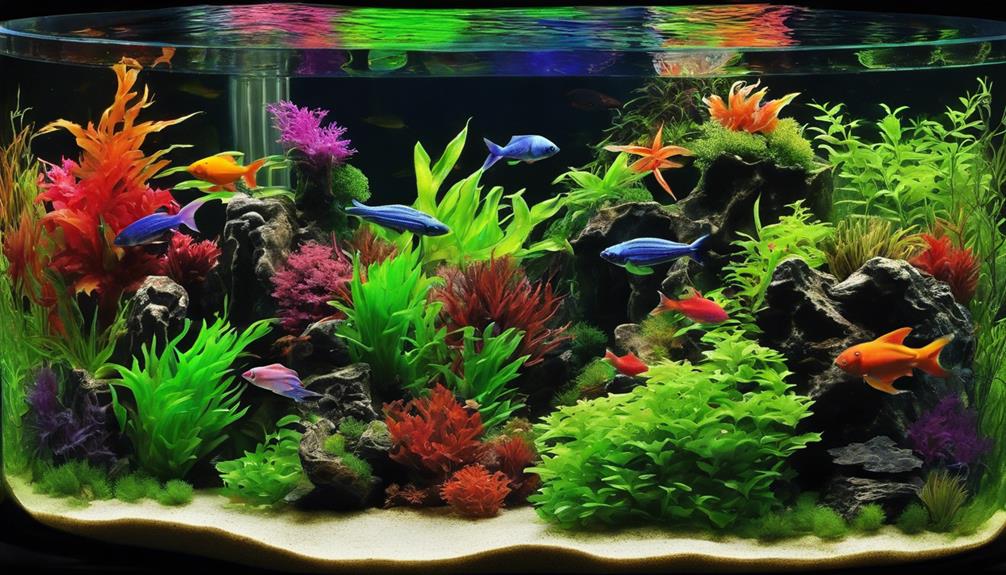
Moving from addressing stressors to fostering a thriving aquatic environment, establishing a solid plan for a healthy aquarium is key. Regularly monitoring tank water parameters such as pH, ammonia, and nitrite levels is essential for maintaining water quality.
Creating a consistent routine for feeding, cleaning, and maintenance helps to sustain a harmonious tank environment. Proper planning and preparation for any changes in the aquarium can prevent stress and guarantee the well-being of your fish.
It's vital to implement stress-reducing techniques like providing hiding spots and selecting suitable tank mates to promote fish activity. Additionally, ensuring a balanced tank environment with appropriate decor, lighting, and high water quality supports the overall health of your aquarium inhabitants.
Frequently Asked Questions
What Does It Mean When a Fish Stays in the Same Spot?
When my fish stays in one spot, it may indicate stress or discomfort. Checking water quality and providing stimulation can assist. Observing behavior changes is vital for their health. Addressing underlying issues guarantees their well-being.
Why Is My Fish Suddenly so Active?
Feeling amazed at my fish's sudden burst of energy? Changes in the environment, like temperature and tank setup, can spark their activity levels. A diverse diet and engaging surroundings can also encourage their lively behavior.
Why Do Fish Stay in Their Zone?
Fish stay in their zone due to stress, discomfort, or feeling threatened. Water quality issues, inadequate hiding spots, and lack of stimulation can contribute. Changes in behavior signal underlying problems. Monitoring behavior closely is key for addressing issues.
What Does It Mean When a Fish Isolates Itself?
When a fish isolates itself, it could signal stress, illness, or discomfort. Monitoring behavior is key. A safe, stimulating environment matters. Addressing underlying issues is essential. Ensuring good water quality and suitable hiding spots helps.
Conclusion
To summarize, it's important to pay attention to the behavior of your fish in order to guarantee they're healthy and happy.
Did you know that a healthy fish should swim actively throughout the day, covering about 10-20 times its body length in distance?
By monitoring their behavior, respiration patterns, and color changes, you can identify any signs of distress and take action to minimize stress in your aquarium.
Remember, a happy fish is an active fish!
Dana is our Lead Content Writer, bringing a wealth of knowledge and expertise to our team. With a background deeply rooted in animal studies and a profound love for all creatures, Dana is dedicated to crafting engaging and informative content that resonates with our audience. With Dana at the helm, you can trust that our content is accurate and engaging, catering to the diverse interests of animal enthusiasts everywhere.
Fish
How to Name Your Red Fish
Pondering how to name your red fish? Dive into this guide for vibrant and meaningful name ideas that will bring your fish to life!

When naming your red fish, focus on vibrant colors like Ruby or Scarlet for intensity. Reflect on significant places, events, or qualities to establish emotional connections. Fire-inspired names such as Ember or Blaze infuse vibrancy. Consider media characters like Ariel for charm. Unique location-inspired names add depth. Nature-inspired names like Coralie evoke natural beauty. Explore words from other languages like Rubino for a unique touch. Suggestions like Blaze or Rosalie add personality. For a perfect name, blend color, meaning, and personal significance. Get creative with names to give your red fish a special identity full of character and meaning.
Key Takeaways
- Consider vibrant color and intensity when naming your red fish.
- Reflect on significant places, events, or qualities for emotional connections.
- Choose fire-inspired names like Ember or Blaze for intensity.
- Draw inspiration from media characters for a special connection.
- Opt for nature-inspired or meaningful names like Rouge or Phoenix.
Consider Your Fishs Color
When choosing a name for your red fish, consider its vibrant color as a key factor. The rich red hue of your fish presents an opportunity to give it a name that truly reflects its striking appearance.
Names like Ruby or Garnet can emphasize the vividness of its color, while options like Scarlet or Crimson can highlight the intensity of its red tones. Choosing a name that complements the deep red shades of your fish, such as Merlot or Burgundy, can add an extra layer of significance to your pet's identity.
For those looking to connect the name of their red fish with its color on a more personal level, names like Sangria or Port can evoke a sense of richness and depth. Ultimately, selecting a name that resonates with the vibrant redness of your fish can create a meaningful and fitting choice that enhances your bond with your aquatic companion.
Reflect on Personal Significance

Reflecting on the personal significance of your red fish can lead to a deeper connection and a more meaningful naming process. When considering the personal significance of your red fish, there are a few key aspects to ponder:
- Naming your red fish after a significant place, event, or memory in your life can create a strong emotional bond.
- Reflecting on unique characteristics or behaviors of your red fish can help you choose a name that truly represents its personality.
- Incorporating elements of your red fish's habitat or environment into its name adds a special touch and connection to its natural surroundings.
- Selecting a name that symbolizes qualities like strength, resilience, or other characteristics you admire in your red fish can reinforce the bond you share.
Fire-Inspired Names
Exploring fire-inspired names for your red fish can add a touch of intensity and vibrancy to its identity. Fire-inspired names like Ember, Blaze, Flame, Inferno, or Phoenix can be particularly fitting for a red fish, reflecting both its vibrant color and fiery personality. These names evoke feelings of warmth, energy, and intensity that complement the striking red hue of the fish. By selecting a fire-inspired name, you can introduce a unique and dynamic element to your red fish's character, making it stand out even more.
It's important to investigate the symbolism and meanings associated with fire when choosing a name for your red fish. Fire represents passion, transformation, and power, all of which can resonate with the lively nature of a red fish. So, when deciding on a fire-inspired name for your aquatic companion, consider the emotions and imagery that the name evokes, ensuring it encapsulates the fiery spirit of your red fish.
Movie or Book Characters
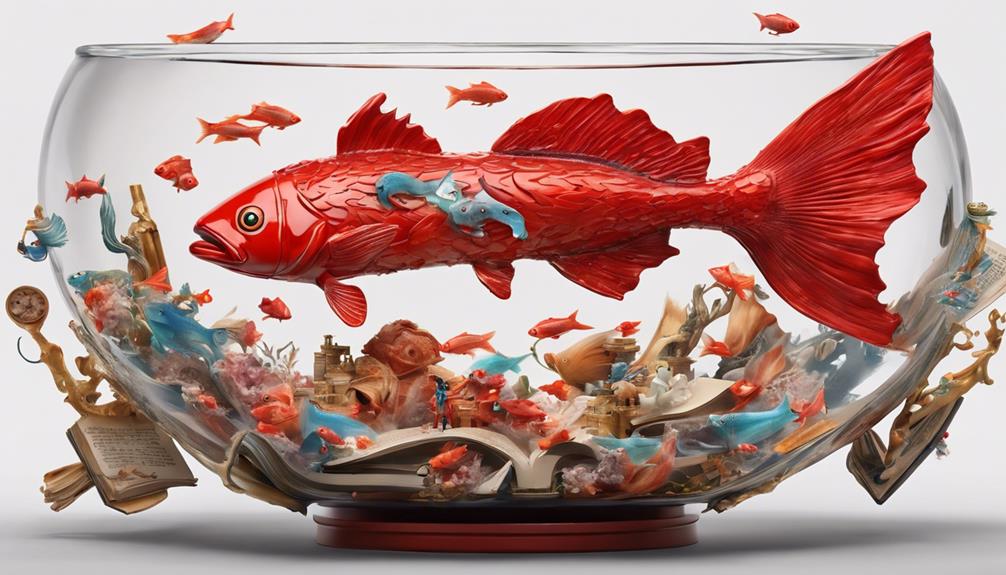
When considering names for your red fish, looking to iconic movie or book characters can be a great source of inspiration. Characters like Ariel from 'The Little Mermaid' or Scarlet Witch from Marvel comics offer unique and memorable options.
Drawing from these fictional favorites can help you find a name that resonates with your fish's personality and creates a special connection.
Iconic Character Names
Which iconic character names from movies or books could inspire a unique and memorable name for your red fish? Consider characters like Ariel, Nemo, Dory, Ursula, or Poseidon for a fun and whimsical touch to your fish's identity.
Drawing inspiration from beloved characters can create a special bond between you and your fish, enhancing the overall experience of caring for them. When selecting a name, think about the personality traits or characteristics associated with the character, and how they align with your red fish.
Fictional Favorites for Fish
Drawing inspiration from iconic characters in movies or books can lead to creative and memorable names for your red fish. Characters like Nemo from 'Finding Nemo' or Flounder from 'The Little Mermaid' offer charming options for naming your aquatic companion. These fictional favorites can infuse personality and charm into your fish's identity, making the naming process enjoyable and meaningful.
Whether you prefer a friendly name like Nemo or a more adventurous moniker like Bruce from 'Finding Nemo,' there are endless possibilities to explore. By choosing a name from beloved movies or books, you not only add a touch of whimsy to your red fish's persona but also create a connection to iconic characters that hold a special place in popular culture.
Finding Inspiration From Media
Gaining inspiration from popular media characters can lead to unique and memorable names for your red fish. Here are some tips on finding the perfect name inspired by movie or book characters:
- Explore Popular Names: Characters like Nemo, Dory, Luca, or Sabrina can offer fun and recognizable choices for your fish.
- Add a Funny Twist: Consider humorous names like Ursula or Sabrina to inject some laughter into your fish's identity.
- Powerful and Mythical: Draw from iconic figures like Poseidon or Triton for a majestic and mythical name for your aquatic companion.
- Reflect Nature: Nature-themed names such as Caspian, Marlin, or River can capture the essence and beauty of your red fish's underwater world.
Finding inspiration from media characters can make the naming process entertaining and meaningful.
Special Place Names
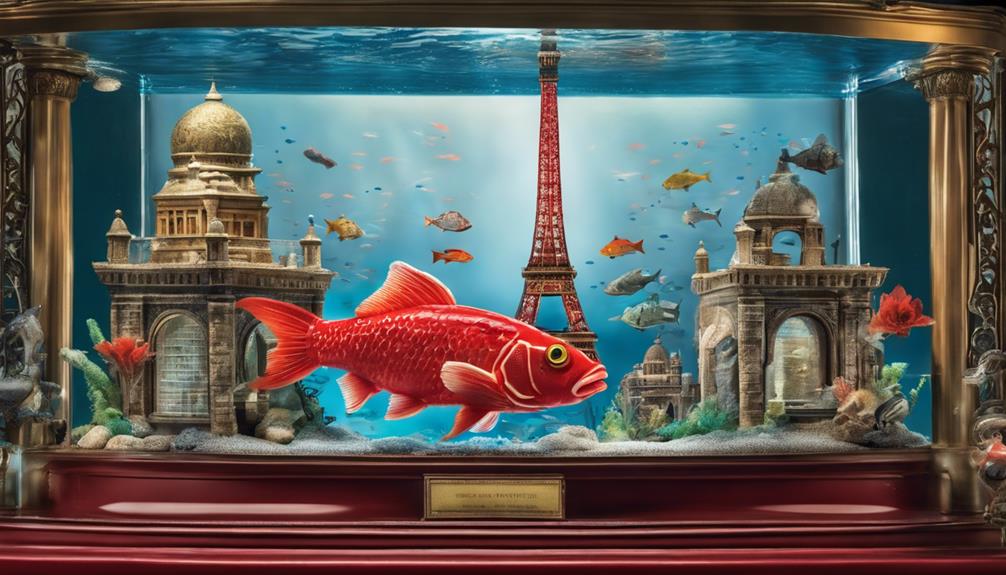
When naming your red fish after a special place, consider unique location-inspired names that hold personal significance, like a treasured vacation spot or a meaningful destination.
Opt for nature-inspired place names that resonate with the vibrant red color of your fish, creating a connection between the name and its appearance.
Reflect on the characteristics of the place you choose, drawing inspiration from its history, culture, or natural beauty to infuse a sense of adventure and personal connection into your fish's identity.
Unique Location-Inspired Names
Considering our personal connections to special places, naming your red fish after a unique location can add a touch of nostalgia and meaning to its identity. Here are some reasons to choose a location-inspired name for your red fish:
- Personal Connection: A name tied to a special place can evoke cherished memories.
- Geographical Significance: It adds a layer of depth and meaning to your fish's identity.
- Conversation Starter: It can spark interesting conversations about the location behind the name.
- Emotional Attachment: Naming your fish after a place you love creates a bond between you and your aquatic companion.
Personal Meaningful Locations
Naming your red fish after a personal meaningful location can infuse its identity with sentimental value and create a unique bond between you and your aquatic companion. Choosing a name that resonates with special memories can deepen the connection you share with your fish, making the naming process more intimate and significant. Below is a table showcasing examples of names inspired by personal locations that could be perfect for your fish:
| Fish Names | Special Place |
|---|---|
| Coral | Great Barrier Reef |
| Aspen | Rocky Mountains |
| Savannah | African Plains |
| Rio | Brazilian River |
| Maui | Hawaiian Island |
Nature-Inspired Place Names
Let's explore how incorporating nature-inspired place names can enhance the unique identity of your red fish.
- Nature-inspired place names like Coralie, Marlin, or River can reflect the aquatic environment where red fish thrive, adding depth to their persona.
- These special names evoke connections to natural habitats such as the Caspian Sea or a serene river setting, enriching the essence of your red fish.
- Choosing a name like Reed can bring tranquility and harmony inspired by nature into your red fish's world.
- Place names such as Coralie highlight the vibrant and colorful nature of red fish, embracing the beauty of their underwater domain.
Meaningful Words in Other Languages
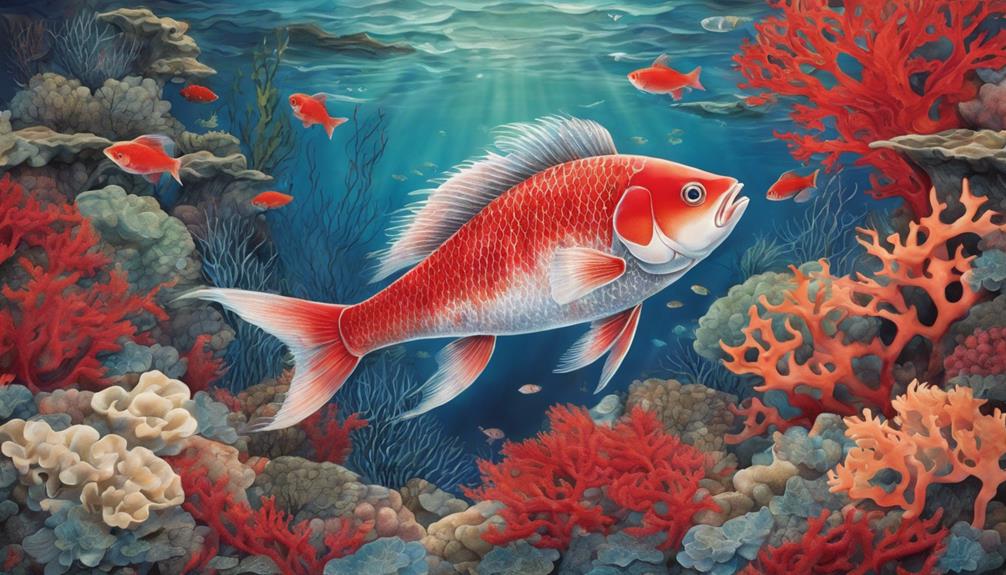
Exploring meaningful words in different languages can enrich the process of naming your red fish, adding cultural depth and uniqueness to the choice. When considering an Italian name, 'rubino' stands out as a beautiful name option for your vibrant red fish, evoking the elegance of a precious gem. The French word 'rouge' offers a sophisticated touch, perfect for a red fish with a flair for the dramatic. In Spanish, 'rojo' captures the essence of red itself, providing a simple yet impactful name for your aquatic companion. For a more exotic and culturally rich choice, Japanese words like 'akane' or 'aka' can infuse your red fish's name with a touch of Eastern mystique. Incorporating these diverse linguistic influences not only sets your fish's name apart but also adds layers of meaning and intrigue to the naming process.
| Language | Meaning |
|---|---|
| Italian | Rubino |
| French | Rouge |
| Spanish | Rojo |
| Japanese | Akane/Aka |
Name Suggestions for Girls
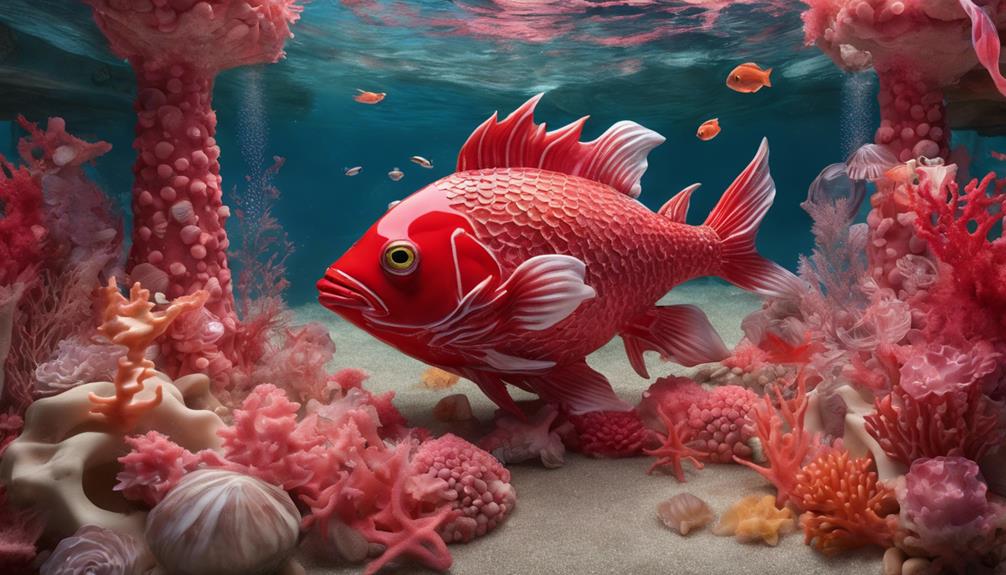
When selecting a name for a girl red fish, consider options that are sweet and simple, nature-inspired, or popular choices among fish enthusiasts.
These names can reflect the vibrant and colorful nature of your red fish, adding a touch of elegance and uniqueness to their identity.
Opt for a name that resonates with the individuality and charm of your fish, ensuring it's easy to remember and suits their personality perfectly.
Sweet and Simple
Sweet and simple names for female red fish like Chelsea, Rosalie, and Spice exude a charming quality that perfectly suits these aquatic companions.
Consider names such as Fiona or Blush for a touch of uniqueness, adding to your pet fish's identity.
Names like Poppy or Terra can bring a sense of individuality to your red fish, while Autumn, Sunset, or Peony may suit those with warm and vibrant personalities.
Valentina, Suri, Foxy, or Sundance reflect the beauty and charm of your red fish, making them perfect choices for your aquatic friend.
Each name carries its own essence, enhancing the bond you share with your beloved pet fish.
Nature-Inspired Names
Nature-inspired names for female red fish can capture the essence of the vibrant hues and beauty found in the natural world. When naming your tropical red fish, consider options like Ruby or Poppy to reflect the intense colors of nature.
Names such as Autumn or Sunset can evoke the warm tones of changing seasons, adding a touch of elegance to your aquarium.
For a delicate and graceful choice, Tulip or Blossom symbolize the beauty of flowers in nature. These nature-inspired names not only connect your red fish to the natural world but also infuse an earthy charm into their identity.
Choose a name that resonates with the organic feel of your aquatic pet, enhancing the beauty of your underwater world.
Popular Choices
Among the popular choices for naming female red fish, names like Donatella, Pandora, and Celeste are highly favored by aquarium enthusiasts. When selecting the perfect name for your aquatic companion, consider these suggestions:
- Sunny: Reflecting the vibrant and warm nature of your red fish.
- Orchid: Adding an elegant and exotic touch to your fish's identity.
- Scarlet: Emphasizing the striking red color of your aquatic friend.
- Aurora: Symbolizing the beauty and grace of your red fish.
These popular names can help create a special bond with your fish, making their identity unique and memorable. Choose a name that resonates with you and captures the essence of your beloved aquatic pet.
Name Suggestions for Boys
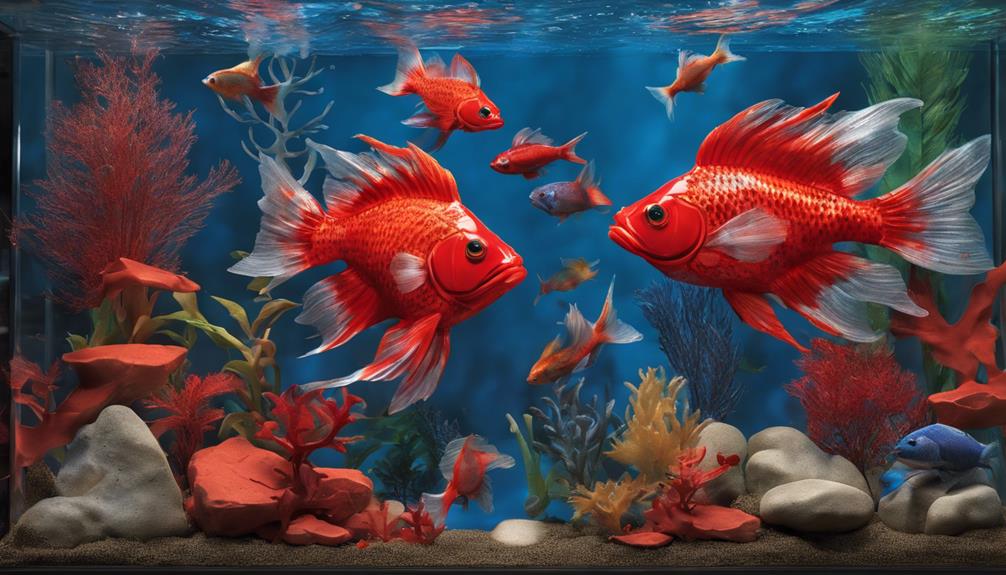
When choosing names for boys, consider drawing inspiration from vibrant colors like Ruby or Crimson. Names like Pike or Coral can be excellent choices for a male red fish, reflecting their bold and striking appearance. Here are some suggestions for naming your red fish:
| Name | Description |
|---|---|
| Ruby | A classic and elegant choice |
| Crimson | Reflects the intense red color |
| Blaze | Perfect for a fiery and active fish |
| Phoenix | Symbolizing rebirth and strength |
| Jasper | Evokes the deep red hues |
| Rusty | Adds a touch of charm and warmth |
Choosing a name that resonates with your pet's personality or characteristics can create a special bond. Unique names like Rosebud or Darth can add a fun twist, while funny names like Grouper or Draco can bring humor to the naming process. Remember, the name you pick should not only sound good but also feel right for your little aquatic friend.
Unisex Name Ideas
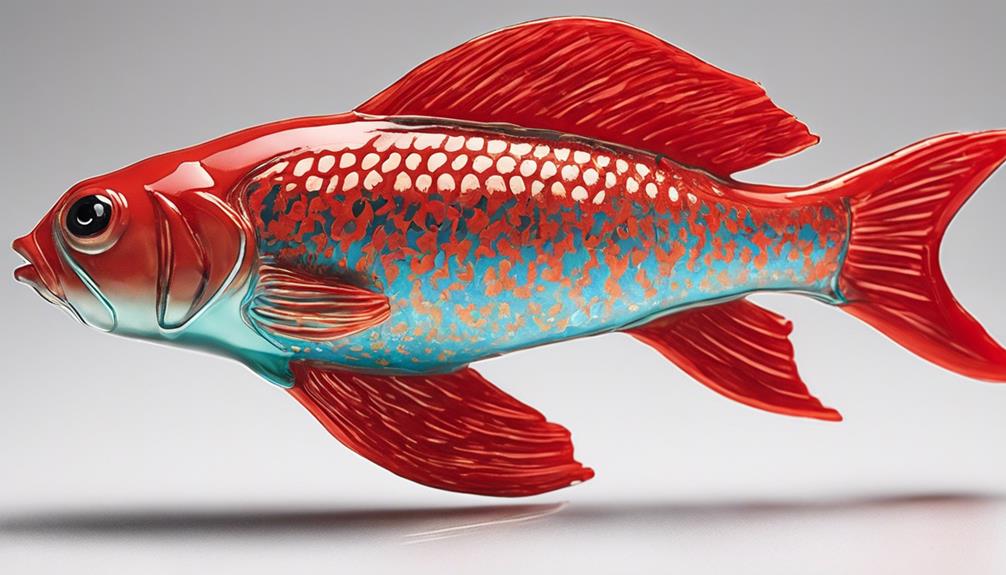
Drawing inspiration from a variety of sources, we can explore versatile unisex name ideas that suit red fish of any gender. When choosing a unisex name for your red fish, consider names that embody inclusivity and creativity.
Here are some unisex name ideas for your red fish:
- Crimson: A vibrant and striking name that reflects the beautiful color of your red fish.
- Blaze: This name signifies energy and intensity, perfect for a lively red fish.
- Ember: A name that evokes warmth and brightness, ideal for a friendly red fish.
- Phoenix: Symbolizing rebirth and renewal, this name adds a mystical touch to your red fish's identity.
These unisex names offer a wide range of options to personalize your red fish's identity while maintaining a gender-neutral approach. Choosing a unisex name can enhance the bond between you and your red fish, adding a fun and distinctive element to your relationship.
Tips for Choosing the Perfect Name
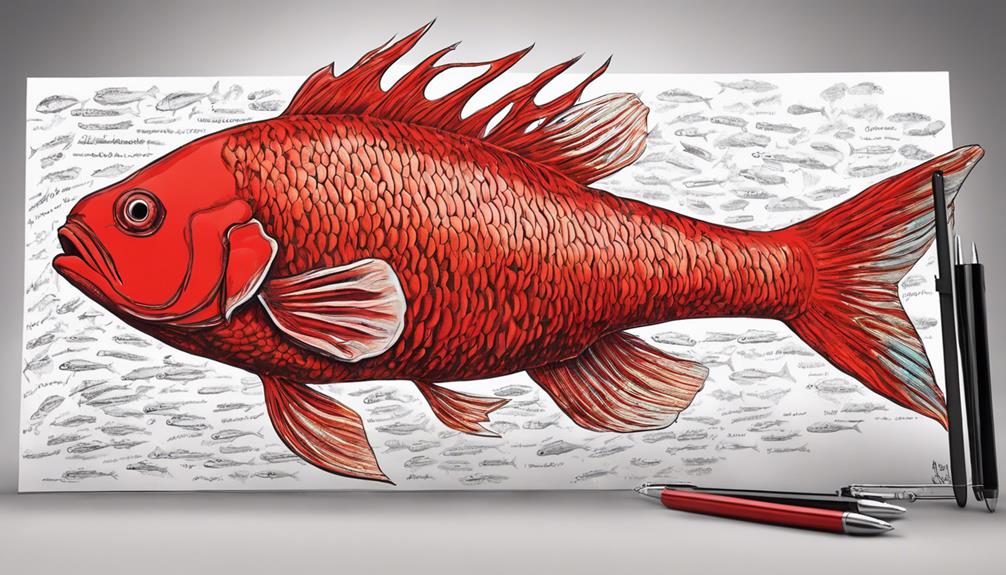
To select the ideal name for your red fish, we should consider its unique personality traits for a more profound connection. When naming your aquatic companion, it's important to think about characteristics that make them special.
Perhaps they've a quirky behavior or a charming way of greeting you. Opt for a name that resonates with these traits to forge a strong bond.
Choosing a name inspired by significant events like a rescue story can add depth to your connection. Make sure the name is easy to remember; this will help in building familiarity and rapport with your red fish.
Reflecting the strength and resilience of your fish in the chosen name can highlight their personality and individuality. Good luck in finding the perfect name that captures the essence of your red fish. Make sure it's a name that both you and your aquatic friend are sure to love.
Frequently Asked Questions
What Is the Nickname for Redfish?
We call Redfish by various names: 'Red Drum,' 'channel bass,' 'reds,' 'bull reds' in Louisiana, or even 'fire truck' for their vibrant color. Each nickname captures a unique aspect of these impressive fish.
How Do I Name My Fish?
We think naming fish involves considering their personality traits and unique characteristics. It's important to choose a name that is easy to remember, reflects strength and resilience, and helps in building a strong bond.
What Is the Name of Red Colour Fish?
We love naming red fish! Consider names like Ruby, Garnet, or Rosebud for a sweet touch. Funny options such as Dexter or Grouper can add playfulness. Unique choices like Admiral or Big Red make your fish stand out.
What Should I Name My Cichlid?
What should we name our cichlid? Let's consider its color, origin, and personality. Maybe something inspired by nature or mythology? The name should be easy to remember and reflect our fish's individuality.
Conclusion
In naming your red fish, consider its color, personal significance, and fire-inspired or character-based names. Choose a name that holds special meaning for you, whether it's a place name or a gender-specific suggestion.
Remember, the perfect name is like a key that opens a door to a world of connection and familiarity with your fish. So take your time, consider your options, and find a name that truly resonates with you and your fish's unique personality.
Happy naming!
As our Editor-in-Chief, James plays a pivotal role in ensuring the quality and integrity of our content. With a keen eye for detail and a passion for storytelling, James oversees the editorial process here at A Place for Animals. With years of experience in content editing, James ensures that every piece of content meets our high standards of accuracy and clarity. Under James’ guidance, you can rest assured that the content you read is informative and impeccably crafted.
Fish
Top 3 Pink Fish Names for Your Aquarium
Illuminate your aquarium with the top 3 pink fish names starting with 'I' that will add a pop of color and personality to your underwater world.
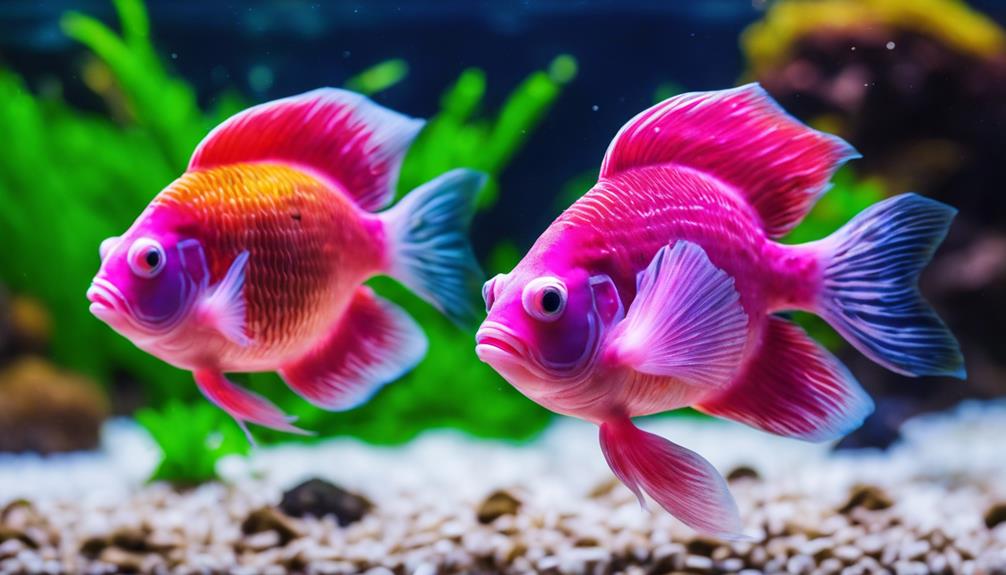
When naming pink fish for your aquarium, consider vibrant options like Blush, Rose, and Magenta. These hues add a lively touch to your aquatic space. For a charming and elegant vibe, names like Ballerina, Tulip, and Rosie are delightful choices. Add a feminine flair with Zinnia or Pink Lady. For a regal touch, go for Duke or Crimson for male fish. If you're into pop culture references, think of names like Kirby, Pink Panther, or Peppa Pig to spark conversations and create a unique persona for your fish. More inspiring names await in the aquatic world.
Key Takeaways
- Consider names like Blush, Rose, and Magenta for a touch of elegance.
- Opt for unique names inspired by pink hues to make your fish stand out.
- Choose sweet names like Ballerina or Tulip for a delightful vibe.
- Explore pop culture references such as Kirby or Pink Panther.
- Elevate your pink fish's presence with a name that complements its coloration.
Shades of Pink Fish Names
When selecting names for pink fish in your aquarium, consider drawing inspiration from a variety of shades, such as blush, rose, and magenta. These hues offer a rich palette to choose from, allowing you to capture the beauty of pink in your fish's name. Shades like Coral, Blush, and Fuchsia evoke different intensities of pink, reflecting the diverse tones found in nature and art.
By exploring the spectrum of pink shades, you can find the perfect name that complements your fish's coloration. Whether you prefer a soft and delicate name like Rose for a gentle pink fish or a vibrant and bold option like Magenta for a more intense hue, the possibilities are endless. Names inspired by specific shades of pink add a unique touch to your fish's identity, making them stand out in your aquarium.
Embrace the beauty of pink with names that reflect the various shades found in the natural world. Let your fish shine with a name that captures the essence of pink in all its glory.
Sweet and Delightful Inspirations
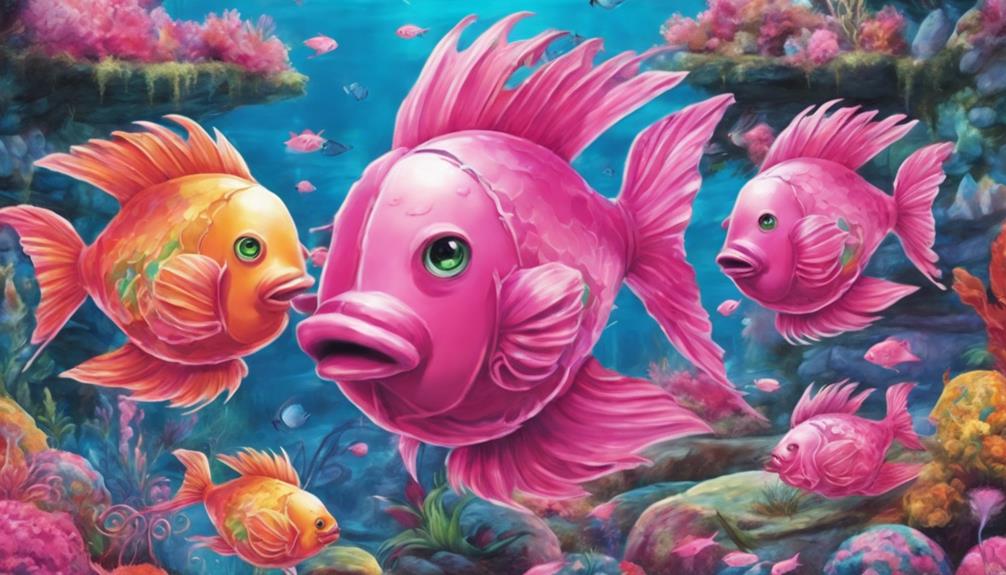
Adding a touch of charm and elegance to your aquarium, sweet and delightful pink fish names can bring a sense of grace and beauty to your aquatic companions. When looking to find the perfect name for your pink fish, consider options that evoke a feeling of cuteness and joy. Names like Ballerina, Tulip, and Rosie aren't only adorable but also reflect the joyful and colorful nature of these aquatic creatures.
For a unique and feminine touch, names such as Zinnia and Pink Lady can be excellent choices. If you have male pink fish, strong and regal names like Duke and Crimson offer a sense of nobility. By selecting a sweet and delightful name, you can create a special bond with your pet fish and enhance the overall ambiance of your aquarium.
Choose wisely, as the right name can truly elevate the presence of your pink fish in their underwater world.
Pop Culture References
Drawing inspiration from popular culture, we can explore exciting and recognizable names for your pink fish. When considering pop culture references for your aquatic companion, characters like Kirby, Pink Panther, and Peppa Pig offer perfect options for naming your pink fish.
These names aren't only cute and memorable but also add a touch of nostalgia to your aquarium. By choosing a name from movies, TV shows, or video games, you can reflect your interests and create a special connection with your fish.
Opting for a pop culture reference can make your pink fish stand out among the others in your aquarium, sparking conversations and admiration from guests. Whether you have a playful Kirby-like fish or a sleek Pink Panther-inspired swimmer, a pop culture name can elevate your pink fish's persona and make them a beloved member of your underwater family.
Frequently Asked Questions
What Is the Pink Fish Called?
We call the pink fish the Rosy Barb. They're lovely freshwater fish with a vibrant pink color. Rosy Barbs are peaceful and enjoy well-planted aquariums. They can grow up to 6 inches and make great community tank inhabitants.
What Is a Cute Name for a Fish?
When picking a cute name for a fish, we aim for something endearing and charming. It's about finding a name that resonates with us and captures the essence of our aquatic friend. Personal connection is key.
What Is the Real Name of the Pink Fish?
The real name of the pink fish commonly found in aquariums is the Rosy Barb. They are vibrant, peaceful, and thrive in schools. These freshwater fish from India, Pakistan, and Bangladesh are social omnivores.
What Should I Name My Cichlid?
When naming our cichlid, let's consider its color, behavior, and unique traits. Researching its species can offer inspiration for a fitting name. Personalizing our aquarium with a name fosters a special bond with our fish.
Conclusion
To sum up, pondering the perfect pink fish names for your aquarium can add a touch of charm and personality to your aquatic environment.
Remember to contemplate the shades of pink, sweet inspirations, and pop culture references to find the ideal name that suits your fish.
By selecting a name that resonates with you, you can create a unique and enjoyable experience for both you and your fish.
So go ahead, get creative, and make your aquarium truly one of a kind.
As our Editor-in-Chief, James plays a pivotal role in ensuring the quality and integrity of our content. With a keen eye for detail and a passion for storytelling, James oversees the editorial process here at A Place for Animals. With years of experience in content editing, James ensures that every piece of content meets our high standards of accuracy and clarity. Under James’ guidance, you can rest assured that the content you read is informative and impeccably crafted.
-

 Vetted2 months ago
Vetted2 months ago15 Best Cat Foods for Managing Hyperthyroidism – Vet Approved and Feline Friendly
-

 Animal Facts2 months ago
Animal Facts2 months agoSpring Animals: A Guide to Seasonal Wildlife
-

 Cats7 months ago
Cats7 months agoTop 5 Cat Breeders in Arkansas: A Guide
-

 Vetted1 month ago
Vetted1 month ago15 Best Dog Foods for Kidney Disease – Expert Recommendations for Your Pet's Health
-

 Vetted2 months ago
Vetted2 months ago15 Best Fresh Dog Food Delivery Services for Your Pup's Health and Happiness
-

 Rabbits2 months ago
Rabbits2 months agoExploring Rabbit Holes: What Do They Look Like?
-

 Pets2 months ago
Pets2 months agoLatest Pet Statistics in US – Trends & Insights in 2024
-
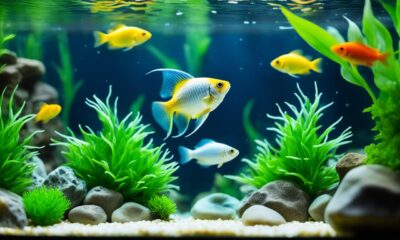
 Fish2 months ago
Fish2 months agoKeeping Your Sucker Fish Thriving at Home






















